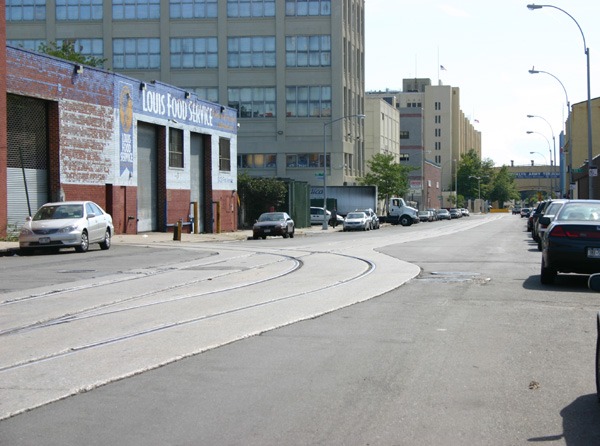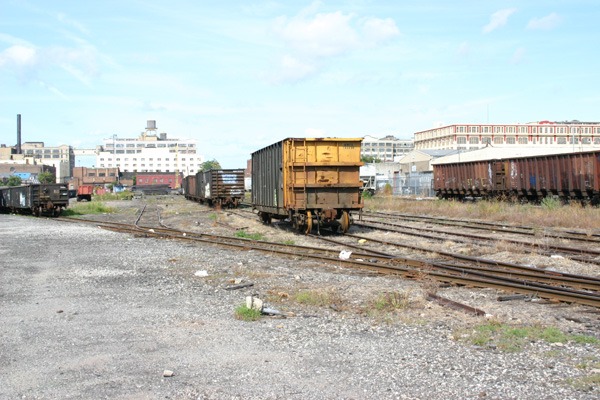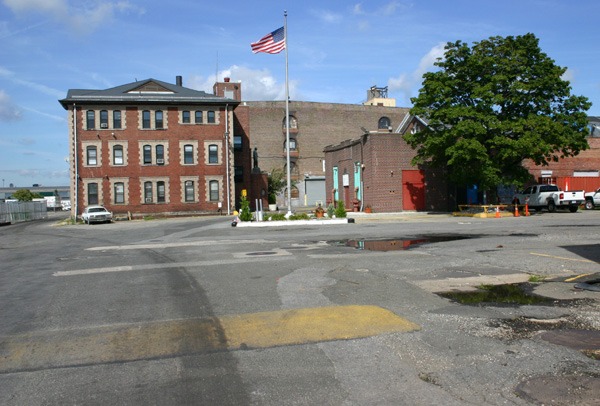My older brother was a model train buff. I always liked the real thing. As a little kid growing up in Japan, my friends and I used to sneak across the mulberry fields and sit by the train tracks to Yokohama. But the local koban police usually caught us and hauled us back home with a stern warning to our parents never to allow it again. That never deterred us. No question about it, we were American brats.

This yard is between me and the Brooklyn Army Terminal. During WW2, 85% of the soldiers bound for Europe arrived on trains in this rail yard before being processed at BAT and boarding ships in the harbor beyond. This was back when there was a Hudson River rail crossing at Poughkeepsie. It burned down in 1974, effectively making an orphan of Brooklyn’s rail access to the outside world.

However, you still see plenty of evidence of those old railroads today, like this one in Brooklyn Heights. It’s from the old New York Dock Railway, parts of which still operate today under the merged NY Cross Harbor Railroad (NYCH).
There are Brooklyn railroad buffs who know lots more about this stuff than I do so I hope I don’t misspeak. My understanding is that Brooklyn railroads had an inherent handicap. Brooklyn is located on an island (Long Island) and there are no rail water crossings here. To get a box car from Bay Ridge to the rail yards across the harbor in New Jersey it had to travel north all the way to Poughkeepsie to cross the Hudson River, then back down again. Because of the myriad rail yards in between, the trip could take as long as five days. By the way, the Jersey rail yard can be seen across the harbor in the above photo.
How primitive, right? Well today it’s actually much worse than it was a hundred years ago. A freight train bound for Brooklyn from New Jersey has to travel 280 miles to go 2 miles. It’s known as the Selkirk Hurdle. Progress.
As a result, the Cross Harbor Railroad was born.
In the first photo you’ll see a couple of large, iron contraptions beyond the freight cars at the water’s edge. Those are float bridges and this was their solution. Freight cars coming from New Jersey or Long Island would be loaded on large barges and tugs would pull them across the harbor. It cut a five day trip down to a few hours, albeit at the cost of lots of barge trips.
There were several of these car float docks up and down the Brooklyn waterfront. I’m told that this one at 65th Street was renovated in 1999. It’s still in operation.

In 2000, the neighborhood learned that the city was in near-final stages of considering to think about contemplating a freight tunnel from 65th Street, where the current rail yard is located, to New Jersey. It’s actually been on our congressman’s (Jerry Nadler) agenda for 35 years. It would be called the Cross-Harbor Rail Tunnel. The local entrance would actually be about a mile east of here.
Bloomberg killed the idea as too costly shortly after he took office but he’s more recently indicated a willingness to review the plan again. At a cost estimated to be as high as $10 billion by the time it’s completed, I think it’s safe to say it will never get off, or under, the ground. It looks like Brooklyn is destined never to have a thriving railroad and its highways will remain clogged with trucks until they collapse. The impetus behind the tunnel wasn’t so much to relieve Brooklyn’s truck traffic but Manhattan’s and the strained bridges and tunnels. But it’s still a good investment. EDC estimates that it costs businesses $2.5 billion/year to send freight by trucks to NYC and Long Island.
But I digress. What’s interesting is the existing Cross Harbor Rail Yard just north of the Brooklyn Army Terminal.


It’s only lightly used these days and it covers many, many acres. It’s only a matter of time before a developer gets its hands on it for a housing development, stadium, corporate park, or perhaps all three.

If you’re interested, two other web sites did a much better job of photo-documenting this rail yard than I ever could:

